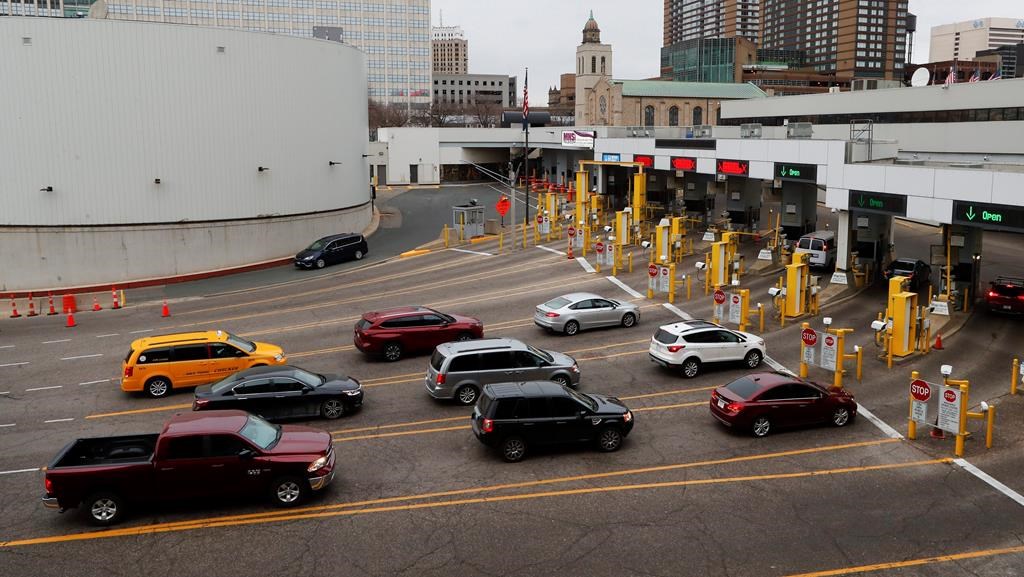There’s no effective way to screen people for the novel coronavirus at the Canada-U.S. border, health experts tell Global News.

This includes the thousands of essential workers — such as nurses, doctors, truckers and airline crews — who are exempted from Canada’s ban on non-essential travel and who continue to move freely across the border.
“There isn’t a magic solution for how to make our borders absolutely airtight,” said Dr. Michael Gardam, an infectious disease specialist and chief of staff at Toronto’s Humber River Hospital.
Gardam says screening measures like those deployed at Canada’s borders — where officers ask travellers if they’re feeling ill and observe for physical signs of sickness — are ineffective.

He says there are several reasons for this: people sometimes lie about their health conditions, and others may not be showing symptoms.
“We know from studies that have been done over the last few months that border screening measures are sort of 50/50,” Gardam said. “They’re not great.”
Gardam said other, more invasive measures, such as checking people’s temperature when they cross the border or get on a plane, may also be unhelpful at detecting the virus because common medications, such as Advil and Tylenol, eliminate symptoms like fever and cough.
“People can answer the questions honestly and not have a temperature and then develop symptoms five minutes after they cross the border,” he said.
Cross-border travel sparks concerns
According to statistics released by the Canada Border Services Agency (CBSA), during the first full week that the new border measures were in place, roughly 317,000 people entered Canada. This includes essential workers, such as commercial trucker drivers, which accounted for nearly half of the 187,000 land border crossings reported by the CBSA.

Get breaking National news
“There is no practical way to do full screening at the border and expect that when you go to the grocery store, food is gonna be on the shelf,” said Windsor, Ont., Mayor Drew Dilkens.
Dilkens is concerned about the safety of roughly 1,600 essential health-care workers who cross the border between Windsor and Detroit on an almost daily basis.
But Dilkens is not advocating for a complete shutdown of the border to nurses and doctors. Doing so would be inhumane and would deprive people living on both sides of the border of vital health-care resources they need in the fight against COVID-19, he said.
Instead of closing the border to essential workers, Dilkens said public health and hospital officials in Canada and the U.S. must ensure staff have access to personal protective equipment (PPE) and that resources are available for people to practise physical distancing whenever possible.
“We know, as the hospitals over there know acutely, that if something were to happen at the border that caused a hard stop, you would literally have entire hospitals that would have to close,” he said.
Health-care workers asked to choose
As of Monday, Michigan had 17,221 confirmed cases of COVID-19 and 727 associated deaths. Roughly a quarter of the cases and an equal proportion of the deaths have been recorded in Detroit.
The sudden acceleration of the virus — which has made Michigan a focal point in the coronavirus outbreak in the U.S. — has Windsor health officials worried.
Dr. Wajid Ahmed, medical officer of health for the Windsor-Essex County Health Unit, said he and his staff recently advised local hospitals to ask nurses and doctors working on both sides of the border to choose whether they wanted to continue working in Canada or the U.S.
Ahmed said the request, which was first reported by the Globe and Mail on Monday, is intended to minimize risk for health-care workers and to prevent transmission of the virus from Detroit to Windsor and vice versa. He said it’s also about reducing the possibility of transmitting the virus from one health-care facility to another.
“If we can reduce the number of crossings, we can reduce the risk,” he said.

In terms of border screening, Ahmed said there isn’t much more that can be done to detect the virus, especially in cases where people haven’t yet developed symptoms.
He said he’s heard talk about doing “spot tests” at the border, which would rely upon fast testing results to determine if someone wanting to enter Canada has COVID-19, but this type of testing can also be problematic because people who carry the virus won’t always test positive in the early stages of the illness.
This could, he said, lead to a “false sense of security” for people who test negative and then move about the community.
Like Gardam, he believes the only effective way to stop the spread of the disease among essential workers is for them to remain vigilant about social distancing and to adhere to other public health recommendations.
He also said prioritizing testing for health-care workers, which Windsor-Essex is doing, is critical for preventing the disease from spreading.
The government, meanwhile, said it has enacted strict screening measures at the border and that anyone who shows signs of illness — regardless of how they answer screening questions — will be referred to public health officials for further questioning.
The CBSA has also stepped up its operations, including observing and questioning travellers at arrivals areas in airports, and is handing out information pamphlets to anyone who enters Canada with details about mandatory self-isolation, physical distancing and other precautionary measures they must follow.
On Monday, Prime Minister Justin Trudeau was asked about health-care workers being forced to choose between working in Canada or the U.S. He said provincial premiers and local mayors are being asked to make “extremely difficult decisions” and that he knows they’ll do what’s right to protect their communities.
He also said it’s important that essential medical supplies and staff be allowed to move across the border uninterrupted.









Comments